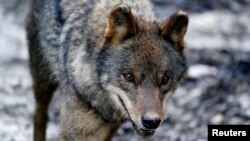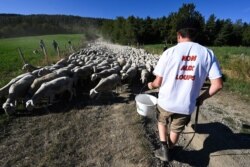After losing 23 sheep in a wolf pack attack one night, Laura Serrano Isla might have been expected to want revenge.
Instead, this farmer is a surprise supporter of Spain’s decision to introduce a nationwide ban on hunting wolves.
“The wolves killed my sheep because we left our animals unprotected and they are predators,” she told VOA.
“We have to live together, and people must realize that the wolf has an important role in hunting wild boar, rabbits and deer. As long as we protect our livestock, we can live together.”
When Serrano, who runs a farm near Burgos in northern Spain, went public with her views, she became the target of attacks — from other farmers and hunters.
“I am not going to back down; they have called me all sorts of names, but it will not change my views,” she insisted.
The wolf has divided society in Spain and beyond for centuries, a figure of evil in Western popular culture that preyed on characters from Little Red Riding Hood to the Three Little Pigs.
With environmentalists across Europe increasingly championing the cause of canis lupus, Spain’s leftist government put an end to decades of hunting which saw the wolf almost driven to extinction.
The Spanish ban will come into force by September, after a long legal battle with regional authorities mostly in northern Spain that opposed the prohibition.
The wolf will be declared a “wild animal in special protection” which means hunting it is illegal.
After progressive measures to preserve the animal in some northern Spanish regions, the wolf has gone from being seen as an enemy to an asset — of the tourism industry.
Until now, hunting was allowed in some regions on a strictly controlled basis.
Spain and Portugal are now thought to be home to about 3,000 wolves, the largest lupine population in Europe, according to data from Ecologists in Action, a conservation group.
Yet opposition to the move persists not just among hunters who believe the wolf must be stamped out.
Wolves kill some 15,000 farm animals across the country every year, according to the Spanish agricultural association COAG.
“Banning hunting is too simple. What is needed is proper control over the wolf,” said Peru Carlos de Munain, a livestock veterinarian in the Basque town of Errigoiti in northern Spain, in an interview with VOA.
“There are many other ways to control wolves —use GPS trackers to show when an attack is about to happen, pen in sheep, provide more shelters for shepherds or even put special chemicals on the sheep which make wolves sick so they never attack sheep again.”
Hunters in some parts of northern Spain have displayed the carcasses of dead wolves in public to show they will not give up the pastime easily.
Lobo Marley, which campaigns to protect wolves, estimates that about 300 are killed by hunters every year.
Changing attitudes
However, in Zamora in northern Spain where once the wolf was hunted, the region has now become a center for lupine tourism.
“Attitudes have completely changed in the past 20 years. It used to be risky to say you liked to track wolves in some bars because there was such animosity to the animal,” said Sergi Garcia, a former wolf tracking guide in Zamora, in an interview with VOA.
“Now they are selling wolf t-shirts and the animal brings in the money.”
The wolf is protected by European Union law but as concern grows the population is growing out of control it has prompted pressure for controlled culls.
In 2018, France approved a cull of 40 wolves after a wave of protests from farmers that the predator was butchering livestock.
When Germany's population reached 60 packs, the government called for a similar cull.
Finland has culled its population down to 150 packs, while Norway killed half its population of 100 animals.
The EU allowed Estonia, which has the highest density of wolves in the continent, to allow hunting as long as the general population remained stable.
Ukraine allows unregulated hunting, while in Bulgaria wolves are considered pests and there is a bounty equal to two weeks’ wages put on their heads. The same tolerance of hunting exists in Belarus.
Russia ended government-controlled culls after the end of the Soviet Union but hunting is legal. Moscow allows wolves to be poisoned.









